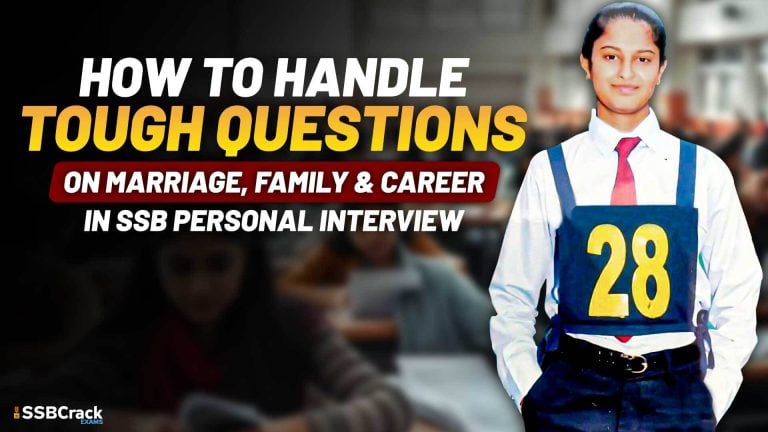The Personality and Psychological Test (PPDT) is a crucial component of the selection process for various defence services. One of the most significant parts of this test is the storytelling segment, where candidates must narrate a story based on a given picture within a limited timeframe. This article will guide you through effective strategies to prepare your story narration in just five minutes, ensuring you present your ideas clearly and confidently.
Story narration in the PPDT is not merely about creativity; it serves as a window into your personality, thought process, and ability to communicate. Here’s why it matters:
Also Read | 5 Tips to Tackle the Fish Market Chaos in PPDT
1. Showcases Creativity and Imagination
- The ability to create a compelling narrative demonstrates your imaginative capabilities.
- A well-structured story reflects your analytical thinking and problem-solving skills.
2. Reveals Personal Traits
- The characters and scenarios you choose can highlight your values and priorities.
- How you resolve conflicts in your story can indicate your leadership qualities and decision-making style.
3. Enhances Communication Skills
- Clear storytelling is essential for effective communication, a critical skill in the defence sector.
- Your narration style can reflect your confidence and ability to engage an audience.
Preparing for the PPDT: Key Strategies
Preparation is key to success in the PPDT. Here are some strategies to help you get ready for the story narration segment.
1. Familiarize Yourself with the Format
- Understand the structure of the PPDT and what is expected during the storytelling phase.
- Review past PPDT examples to get a feel for the types of images and stories used.
2. Practice Story Creation
- Regularly practice creating stories from random images to improve your spontaneity.
- Focus on developing a central theme or message in your stories.
3. Build a Story Framework
- Structure your stories using a simple framework: introduction, conflict, resolution, and conclusion.
- This will help you organize your thoughts quickly during the narration.
Quick Tips to Prepare Your PPDT Story
When the time comes to narrate your story, having a few quick tips in mind can make all the difference. Here’s how to maximize those critical five minutes before your narration.
1. Stay Calm and Composed
- Take a few deep breaths to center yourself and reduce anxiety.
- Remind yourself that this is an opportunity to showcase your skills.
2. Visualize Your Story
- Spend a moment visualizing the key elements of your story.
- Picture the main character, setting, and the unfolding events in your mind.
3. Focus on Key Points
- Concentrate on the main events and characters rather than memorizing every word.
- This will help you convey your story more naturally and confidently.
4. Practice with a Peer
- If possible, share your story with a fellow candidate or a friend.
- This practice can help you gain confidence and receive constructive feedback.
5. Maintain a Positive Attitude
- Replace negative thoughts with positive affirmations about your abilities.
- Confidence can significantly enhance your delivery.
Also Read | Why Indian Armed Forces Have Different Salutes
Structuring Your Story Effectively
A well-structured story can make a lasting impression. Here’s how to organize your narrative effectively:
1. Introduction
- Introduce the main character and setting.
- Set the tone for the story and engage your audience.
2. Conflict
- Present a challenge or problem that the main character faces.
- This is where the audience becomes invested in the outcome.
3. Climax
- Describe the turning point where the character must confront the conflict.
- This moment should be compelling and emotionally charged.
4. Resolution
- Conclude the story by showing how the character resolves the conflict.
- Highlight any lessons learned or changes in the character.
5. Conclusion
- Wrap up your narration with a strong closing statement.
- Reinforce the main message or theme of your story.
Tips for Confident Delivery
Once you have prepared your story, the next step is to deliver it with confidence. Here are some delivery tips:
1. Body Language
- Maintain an open and confident posture while narrating.
- Use gestures to emphasize key points in your story.
2. Vocal Modulation
- Vary your tone and pace to keep the audience engaged.
- Emphasize important parts of the story to convey emotion.
3. Eye Contact
- Make eye contact with your audience to create a connection.
- This will enhance your credibility and engagement.
4. Practice Makes Perfect
- Rehearse your story multiple times to improve fluency.
- The more comfortable you are with your story, the more confident you will feel.
Managing Time Effectively During PPDT
Time management is crucial during the PPDT. Here’s how to make the most of your limited time:
1. Allocate Time Wisely
- Spend the first minute analyzing the image and brainstorming ideas.
- Dedicate the next three minutes to structuring your story.
2. Keep It Concise
- Aim for a story that can be narrated in about two to three minutes.
- Avoid unnecessary details that may dilute the main message.
3. Practice Under Time Constraints
- Simulate the PPDT environment by practicing your narration within a set time limit.
- This will help you become accustomed to the pressure of the actual test.
Overcoming Nervousness Before Narration
Feeling nervous before your narration is normal. Here are some strategies to help you manage anxiety:
1. Positive Visualization
- Visualize yourself successfully delivering your story.
- Imagine the positive reactions from the audience.
2. Breathing Techniques
- Practice deep breathing exercises to calm your nerves.
- Inhale deeply through your nose, hold for a few seconds, and exhale slowly.
3. Affirmations
- Repeat positive affirmations to boost your confidence.
- Remind yourself of your preparation and capabilities.
Learning from Feedback
After the PPDT, seeking feedback can be incredibly beneficial. Here’s how to leverage feedback for improvement:
1. Self-Reflection
- Reflect on your performance and identify areas for improvement.
- Consider what worked well and what could be enhanced.
2. Peer Feedback
- Discuss your performance with peers or mentors who witnessed your narration.
- Constructive criticism can provide valuable insights.
3. Continuous Practice
- Use the feedback to refine your storytelling skills.
- Regular practice will help you build confidence and improve your delivery.
Resources for Further Preparation
To further enhance your preparation for the PPDT, consider utilizing the following resources:
| Resource Type | Description |
|---|---|
| Books | Look for books focused on storytelling and communication skills. |
| Online Courses | Enroll in courses that offer training in public speaking and storytelling. |
| Mock Interviews | Participate in mock interviews to simulate the PPDT experience. |
| Peer Study Groups | Join study groups with fellow aspirants for collaborative learning. |
Also Read | 9 Facts You Didn’t Know About the Rashtriya Rifles
Conclusion
Preparing for the PPDT story narration requires a blend of creativity, structure, and confidence. By following the quick tips outlined in this article, you can enhance your storytelling skills and present your narrative effectively. Remember, the key is to stay calm, focus on the main points, and practice regularly. With time and effort, you’ll be well-equipped to impress the evaluators and showcase your potential.
FAQs
Q1: How can I improve my storytelling skills for the PPDT?
Regular practice, reading diverse stories, and analyzing effective narratives can significantly improve your storytelling skills.
Q2: What should I focus on during the five minutes before my narration?
Use this time to calm yourself, visualize your story, and rehearse the key points.
Q3: Is it necessary to memorize my story word for word?
No, focus on understanding the central idea and key elements rather than memorizing every detail.
Q4: How can I manage my anxiety before narrating my story?
Practice deep breathing, visualize success, and use positive affirmations to manage anxiety effectively.






















